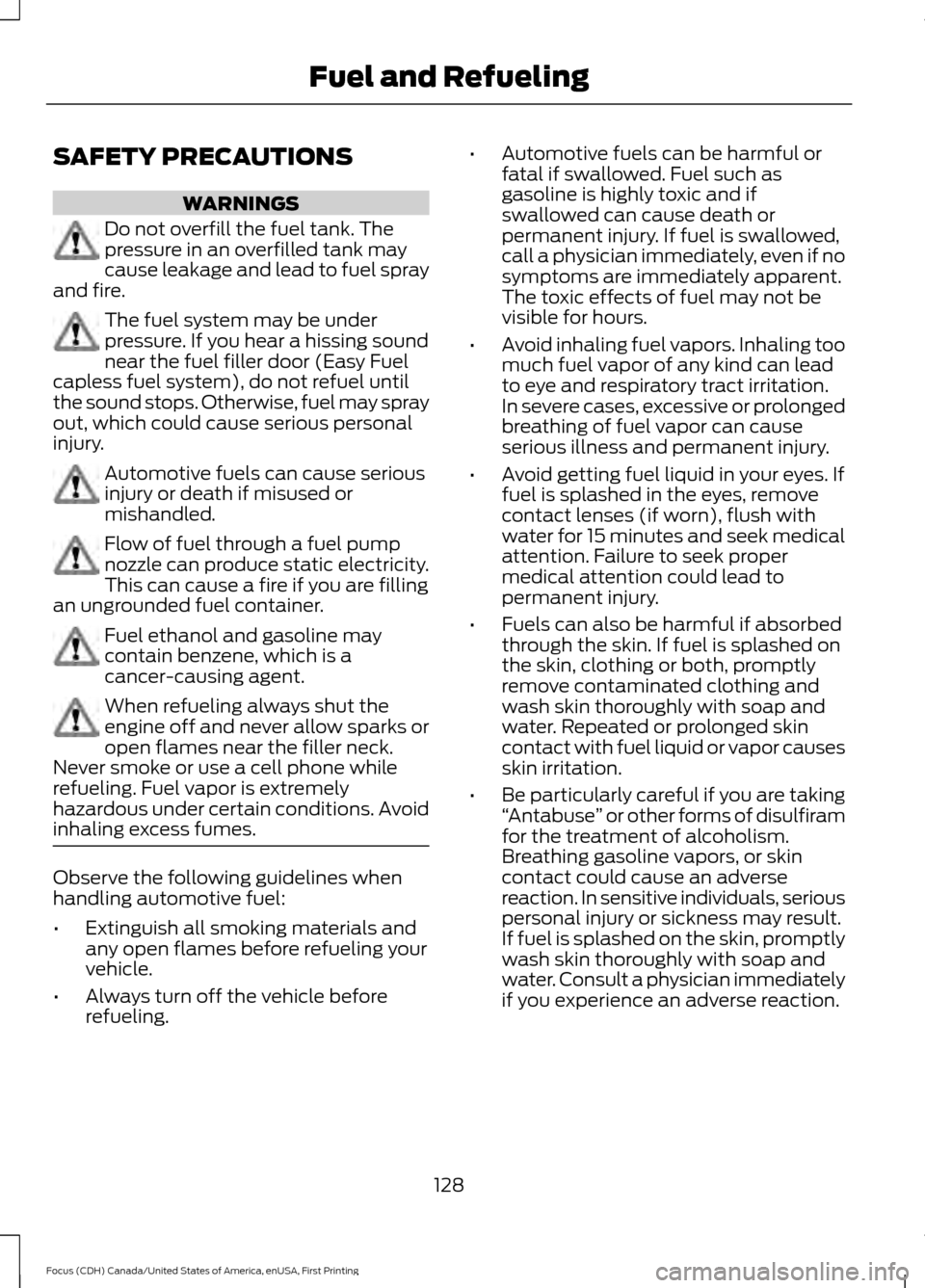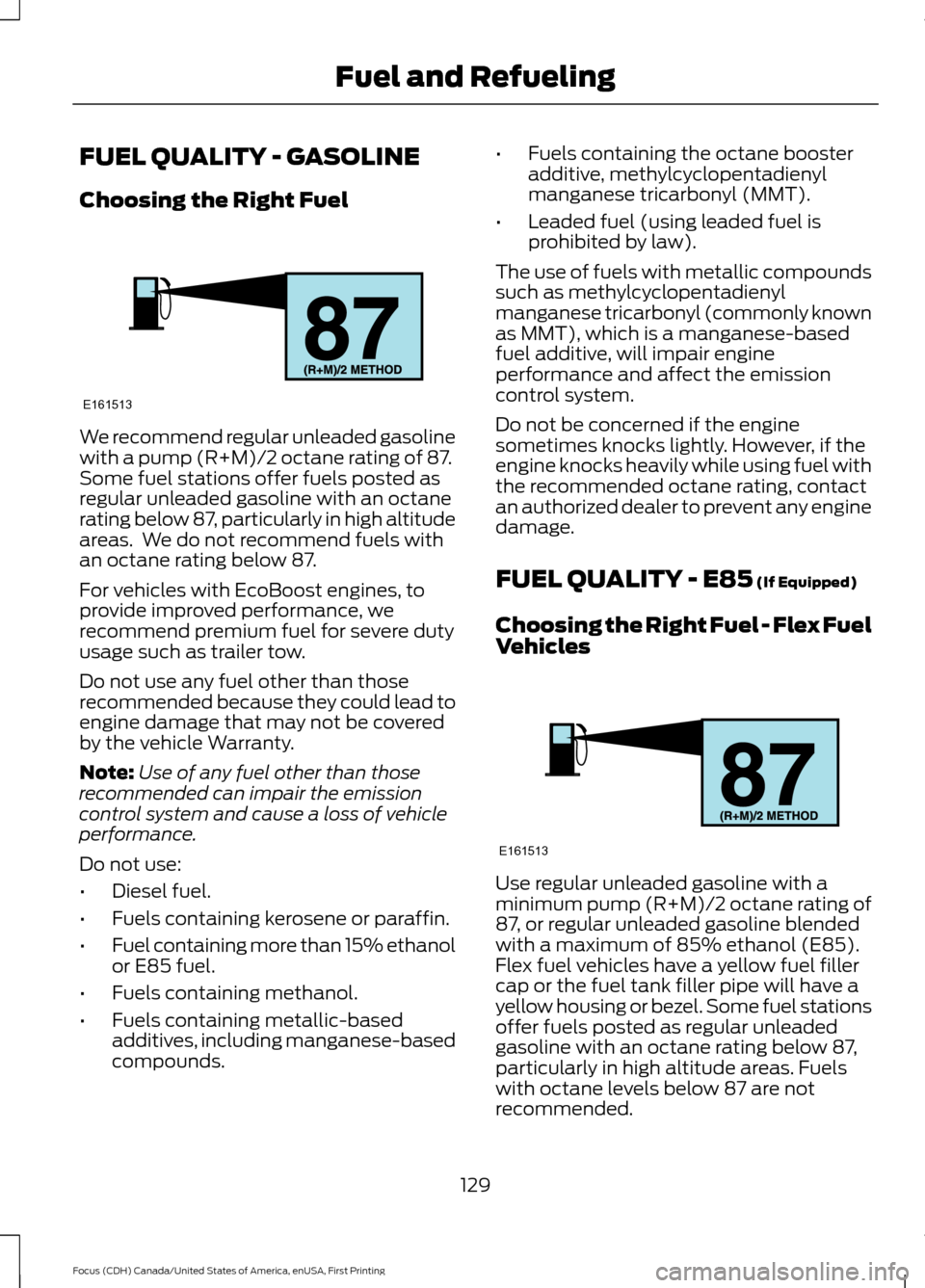2016 FORD FOCUS open gas tank
[x] Cancel search: open gas tankPage 131 of 385

SAFETY PRECAUTIONS
WARNINGS
Do not overfill the fuel tank. The
pressure in an overfilled tank may
cause leakage and lead to fuel spray
and fire. The fuel system may be under
pressure. If you hear a hissing sound
near the fuel filler door (Easy Fuel
capless fuel system), do not refuel until
the sound stops. Otherwise, fuel may spray
out, which could cause serious personal
injury. Automotive fuels can cause serious
injury or death if misused or
mishandled.
Flow of fuel through a fuel pump
nozzle can produce static electricity.
This can cause a fire if you are filling
an ungrounded fuel container. Fuel ethanol and gasoline may
contain benzene, which is a
cancer-causing agent.
When refueling always shut the
engine off and never allow sparks or
open flames near the filler neck.
Never smoke or use a cell phone while
refueling. Fuel vapor is extremely
hazardous under certain conditions. Avoid
inhaling excess fumes. Observe the following guidelines when
handling automotive fuel:
•
Extinguish all smoking materials and
any open flames before refueling your
vehicle.
• Always turn off the vehicle before
refueling. •
Automotive fuels can be harmful or
fatal if swallowed. Fuel such as
gasoline is highly toxic and if
swallowed can cause death or
permanent injury. If fuel is swallowed,
call a physician immediately, even if no
symptoms are immediately apparent.
The toxic effects of fuel may not be
visible for hours.
• Avoid inhaling fuel vapors. Inhaling too
much fuel vapor of any kind can lead
to eye and respiratory tract irritation.
In severe cases, excessive or prolonged
breathing of fuel vapor can cause
serious illness and permanent injury.
• Avoid getting fuel liquid in your eyes. If
fuel is splashed in the eyes, remove
contact lenses (if worn), flush with
water for 15 minutes and seek medical
attention. Failure to seek proper
medical attention could lead to
permanent injury.
• Fuels can also be harmful if absorbed
through the skin. If fuel is splashed on
the skin, clothing or both, promptly
remove contaminated clothing and
wash skin thoroughly with soap and
water. Repeated or prolonged skin
contact with fuel liquid or vapor causes
skin irritation.
• Be particularly careful if you are taking
“Antabuse ” or other forms of disulfiram
for the treatment of alcoholism.
Breathing gasoline vapors, or skin
contact could cause an adverse
reaction. In sensitive individuals, serious
personal injury or sickness may result.
If fuel is splashed on the skin, promptly
wash skin thoroughly with soap and
water. Consult a physician immediately
if you experience an adverse reaction.
128
Focus (CDH) Canada/United States of America, enUSA, First Printing Fuel and Refueling
Page 132 of 385

FUEL QUALITY - GASOLINE
Choosing the Right Fuel
We recommend regular unleaded gasoline
with a pump (R+M)/2 octane rating of 87.
Some fuel stations offer fuels posted as
regular unleaded gasoline with an octane
rating below 87, particularly in high altitude
areas. We do not recommend fuels with
an octane rating below 87.
For vehicles with EcoBoost engines, to
provide improved performance, we
recommend premium fuel for severe duty
usage such as trailer tow.
Do not use any fuel other than those
recommended because they could lead to
engine damage that may not be covered
by the vehicle Warranty.
Note:
Use of any fuel other than those
recommended can impair the emission
control system and cause a loss of vehicle
performance.
Do not use:
• Diesel fuel.
• Fuels containing kerosene or paraffin.
• Fuel containing more than 15% ethanol
or E85 fuel.
• Fuels containing methanol.
• Fuels containing metallic-based
additives, including manganese-based
compounds. •
Fuels containing the octane booster
additive, methylcyclopentadienyl
manganese tricarbonyl (MMT).
• Leaded fuel (using leaded fuel is
prohibited by law).
The use of fuels with metallic compounds
such as methylcyclopentadienyl
manganese tricarbonyl (commonly known
as MMT), which is a manganese-based
fuel additive, will impair engine
performance and affect the emission
control system.
Do not be concerned if the engine
sometimes knocks lightly. However, if the
engine knocks heavily while using fuel with
the recommended octane rating, contact
an authorized dealer to prevent any engine
damage.
FUEL QUALITY - E85 (If Equipped)
Choosing the Right Fuel - Flex Fuel
Vehicles Use regular unleaded gasoline with a
minimum pump (R+M)/2 octane rating of
87, or regular unleaded gasoline blended
with a maximum of 85% ethanol (E85).
Flex fuel vehicles have a yellow fuel filler
cap or the fuel tank filler pipe will have a
yellow housing or bezel. Some fuel stations
offer fuels posted as regular unleaded
gasoline with an octane rating below 87,
particularly in high altitude areas. Fuels
with octane levels below 87 are not
recommended.
129
Focus (CDH) Canada/United States of America, enUSA, First Printing Fuel and RefuelingE161513 E161513
Page 379 of 385

Fuel and Refueling.......................................128
Fuel Consumption........................................133 Calculating Fuel Economy............................... 133
Filling the Tank..................................................... 133
Fuel Filler Funnel Location
........................130
Fuel Filter........................................................220
Fuel Quality - E85.........................................129 Choosing the Right Fuel - Flex Fuel
Vehicles............................................................. 129
Fuel Quality - Gasoline...............................129 Choosing the Right Fuel................................... 129
Fuel Shutoff
...................................................190
Fuses.................................................................201
Fuse Specification Chart...........................201 Engine Compartment Fuse Box.................... 201
Luggage Compartment Fuse Box................207
Passenger Compartment Fuse Box...........205
G
Gauges...............................................................86 Engine Coolant Temperature Gauge............86
Fuel Gauge.............................................................. 87
Information Display............................................. 86
General Information on Radio Frequencies...................................................45
General Maintenance Information
.......336
Multi-Point Inspection..................................... 338
Owner Checks and Services.......................... 337
Protecting Your Investment........................... 336
Why Maintain Your Vehicle?......................... 336
Why Maintain Your Vehicle at Your Dealership?..................................................... 336
Getting Assistance Outside the U.S. and Canada..........................................................197
Getting the Services You Need...............194 Away From Home.............................................. 194
H
Handbrake See: Parking Brake............................................. 145
Hazard Warning Flashers..........................190
Headlamp Adjusting See: Adjusting the Headlamps..................... 223
Headlamp Exit Delay....................................76
Headlamp Removal See: Removing a Headlamp.......................... 224Head Restraints.............................................110
Adjusting the Head Restraint........................... 111
Tilting Head Restraints ..................................... 112
Heated Seats...................................................115
Heated Steering Wheel.................................71
Heated Windows and Mirrors..................108 Heated Exterior Mirrors.................................... 108
Heated Rear Window....................................... 108
Heating See: Climate Control......................................... 103
Hill Start Assist..............................................145 Switching the System On and Off...............146
Using Hill Start Assist....................................... 146
Hints on Controlling the Interior Climate
..........................................................106
Cooling the Interior Quickly............................. 107
General Hints....................................................... 106
Heating the Interior Quickly............................ 106
Recommended Settings for Cooling ..........107
Recommended Settings for Heating..........107
Side Window Defogging in Cold Weather............................................................ 108
Hints on Driving With Anti-Lock Brakes............................................................144
Hood Lock See: Opening and Closing the Hood............212
I
Ignition Switch................................................118
In California (U.S. Only).............................195
Information Display Control.......................70
Information Displays
......................................91
General Information............................................. 91
376
Focus (CDH) Canada/United States of America, enUSA, First Printing Index